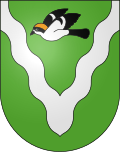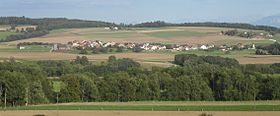Burtigny
| Burtigny | |
|---|---|
| State : |
|
| Canton : |
|
| District : | Nyon |
| BFS no. : | 5854 |
| Postal code : | 1261 |
| Coordinates : | 509 341 / 146 833 |
| Height : | 737 m above sea level M. |
| Height range : | 620–896 m above sea level M. |
| Area : | 5.68 km² |
| Residents: | 391 (December 31, 2018) |
| Population density : | 69 inhabitants per km² |
| Website: | www.burtigny.ch |
|
Burtigny |
|
| Location of the municipality | |
Burtigny is a municipality in the Nyon district in the canton of Vaud in Switzerland .
geography
Burtigny is 737 m above sea level. M. , 10 km north of the district capital Nyon (linear distance). The street row village extends on a plateau slightly sloping to the south between the Serine and its eastern tributary Moteline, on the southern slope of the Jura , in a panoramic position around 350 m above lake level of Lake Geneva .
The area of the 5.7 km² municipal area includes a section on the southern slope of the Jura. The community soil extends from the Serine valley to the east on the high plateau near Burtigny, which is drained by the moteline . To the east of this plateau is the Grandes Tattes forest area , in which at 895 m above sea level. M. (above the Vaudois Côte) the highest point of Burtigny is reached. The northern border runs in the winding valley of Prévondavaux , which is occupied by a protected marshland. The valley of Prévondavaux is a testimony to the last ice age , it was once a meltwater channel on the edge of the ice age Rhone glacier . In 1997, 5% of the municipal area was in settlements, 35% in forests and woodlands, 59% in agriculture and just over 1% was unproductive land.
Numerous individual farms belong to Burtigny. Neighboring municipalities to Burtigny are Begnins , Le Vaud , Marchissy , Longirod , Saint-Oyens , Essertines-sur-Rolle , Gilly , Bursins , Vinzel and Luins .
population
With 391 inhabitants (as of December 31, 2018), Burtigny is one of the small communities in the canton of Vaud. Of the residents, 83.3% are French-speaking, 7.1% German-speaking and 5.5% English-speaking (as of 2000). The population of Burtigny was 362 in 1850, and 369 in 1900. After the population had decreased to 216 by 1970, an increasing trend has been observed since then.
economy
Burtigny was a predominantly agricultural village until the second half of the 20th century . Agriculture still plays an important role as a livelihood for the population, with arable farming and cattle breeding predominating. Burtigny is the location of a cork factory, further jobs are available in the service sector. In the last few decades the village has developed into a residential community thanks to its attractive location. Many workers are commuters who work mainly in Nyon .
traffic
Although the community is located off the main thoroughfares, it is still easily accessible in terms of traffic on the cantonal road from Gland to Col du Marchairuz . The Gland motorway junction on the A1 (Geneva-Lausanne) opened in 1964 is around 6 km from the town. The village is connected to the public transport network by a Postbus course that runs from Gland to Burtigny.
history
The municipality of Burtigny was settled long before the new era. Bowl stones , smelting systems from the Bronze Age and burial mounds from the Hallstatt Age were found. The first written mention of the place took place in 1144 under the name Britiniaco , in 1145 the spelling Brettignei appeared . Burtigny belonged to the Prangins rule in the Middle Ages . After 1208 it changed hands several times before it finally came to the Lords of Aubonne in 1357 .
With the conquest of Vaud by Bern in 1536, Burtigny came under the administration of the Bailiwick of Aubonne. After the collapse of the Ancien Régime , the village belonged to the canton of Léman from 1798 to 1803 during the Helvetic Republic, which then became part of the canton of Vaud when the mediation constitution came into force . In 1798 it was assigned to the Rolle district. In the 19th century, numerous houses fell victim to two village fires.
Attractions
The parish church of Saint-Pierre, mentioned as early as 1204, was under the Cistercian Abbey of Bonmont . The current building dates largely from 1481, while the rectory was built in 1809. In front of the church there is a 600 year old linden tree. Some farmhouses from the 19th century have been preserved in the village center.
literature
- Paul Bissegger: Les monuments d'art e d'histoire du Canton de Vaud, Tome VII: Rolle et son district. Edited by the Society for Swiss Art History GSK. Bern 2012 (Art Monuments of Switzerland, Volume 120) ISBN 3-7643-1208-4 . Pp. 105-111.
Web links
- Official website of the municipality of Burtigny (French)
- Germain Hausmann: Burtigny. In: Historical Lexicon of Switzerland .
Individual evidence
- ↑ Permanent and non-permanent resident population by year, canton, district, municipality, population type and gender (permanent resident population). In: bfs. admin.ch . Federal Statistical Office (FSO), August 31, 2019, accessed on December 22, 2019 .




